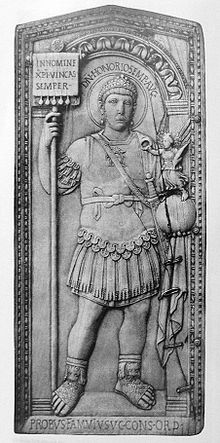Labarum
[9] Harry Thurston Peck, in his Harpers Dictionary of Classical Antiquities, wrote: "The etymology of the term itself has given rise to many conflicting opinions.
"[2] On the evening of October 27, 312 AD, with his army preparing for the Battle of the Milvian Bridge, the emperor Constantine I claimed to have had a vision[4] which led him to believe he was fighting under the protection of the Christian God.
Obeying this command, "he marked on their shields the letter X, with a perpendicular line drawn through it and turned round thus at the top, being the cipher of Christ".
[12] According to this version, Constantine with his army was marching somewhere (Eusebius does not specify the actual location of the event, but it clearly is not in the camp at Rome) when he looked up to the sun and saw a cross of light above it, and with it the Greek words Ἐν Τούτῳ Νίκα.
Eusebius then continues to describe the labarum, the military standard used by Constantine in his later wars against Licinius, showing the Chi Rho sign.
From the cross-bar of the spear was suspended a cloth, a royal piece, covered with a profuse embroidery of most brilliant precious stones; and which, being also richly interlaced with gold, presented an indescribable degree of beauty to the beholder.
"The emperor constantly made use of this sign of salvation as a safeguard against every adverse and hostile power, and commanded that others similar to it should be carried at the head of all his armies.
If Eusebius' oath-confirmed account of Constantine's vision and the role it played in his victory and conversion can be trusted, then a grand opportunity for the kind of political propaganda that the Arch was built to present was missed.
Many historians have argued that in the early years after the battle, the Emperor had not yet decided to give clear public support to Christianity, whether from a lack of personal faith or because of fear of religious friction.
The arch's inscription does say that the Emperor had saved the res publica INSTINCTV DIVINITATIS MENTIS MAGNITVDINE ("by greatness of mind and by instinct [or impulse] of divinity").
During the attack of Constantine's troops at the Battle of Adrianople the guard of the labarum standard were directed to move it to any part of the field where his soldiers seemed to be faltering.
A later Byzantine manuscript indicates that a jewelled labarum standard believed to have been that of Constantine was preserved for centuries, as an object of great veneration, in the imperial treasury at Constantinople.






